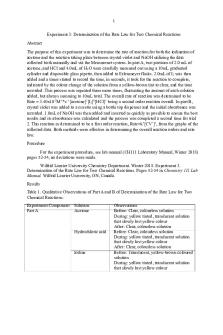Rate Law Worksheet Answers PDF

| Title | Rate Law Worksheet Answers |
|---|---|
| Course | Chemistry for Pre-Health 2 |
| Institution | Mohawk College |
| Pages | 2 |
| File Size | 90 KB |
| File Type | |
| Total Downloads | 6 |
| Total Views | 155 |
Summary
Rate Law Worksheet Answers...
Description
Rate Law Worksheet
1. The rate of formation of OI— in the chemical reaction OCl— + I— à OI— + Cl— is given by the rate law: '() — [,— ] !"#$ = & ['.— ] What is the overall reaction order and the order with respect to OH—? •
overall reaction order is 1
•
order with respect to OH— is —1
2. The rate law for the reaction A + 2B à C is second order in A and second order in B and has a rate constant of 1.25 × 10—2 s—1 at 30 ºC. Find the rate of reaction when the concentration of A is 0.27 Mand the concentration of B is 0.32 M. rate = k[A]6 [B]6 = 1.25×10=6(0.27)6 (0.32)6 = 9.3×10=C •
the rate of the reaction is 9.3×10=C M/s
3. For the general chemical reaction, A + B à products, the following data were obtained from three experimental trials: Exp.
Initial [A]o (mol/L)
Initial [B]o (mol/L)
Initial Rate of Formation of Products (M s—1)
1
0.040
0.040
9.6 × 10—6
2
0.080
0.040
1.92 × 10—5
3
0.080
0.020
9.6 × 10—6
a. Determine the rate law for this reaction. •
when concentration of A is doubled (exp. 1 to 2), the initial rate doubles o
•
order with respect to A is 1
when concentration of B is doubled (exp. 3 to 2), the initial rate doubles o
order with respect to B is 1
è rate = k A [B] b. Find the rate constant with units. •
using exp. 1 data and the rate law rate = k A B 9.6×10=E FMH =I rate = k= = 6.0×10=K FM=Is =I A [B] (0.040FM)(0.040FM)
c. What is the initial rate of reaction when [A]o = 0.12 M and [B]o = 0.015 M? rate = k A B = 6.0×10=K 0.12 0.015 = 1.1×10=CFMs =I
4. What is the rate equation for the reaction 2C + 2D à E + F, which proceeds by the mechanism given below? 2C ⇄ C2 (equilibrium) C2 +D ⇄ X + E (rate determining) X+D⇄F (rapid) • theFrateFequationFisFrate = k[C]6 [D] 5. For a reaction with the experimental rate law of rate = k[A]2: a. What happens to the rate if the concentration of A is doubled? •
the rate would quadruple
b. What happens to the rate if the concentration of A is reduced to one third the initial concentration? •
the rate would be reduced by two-thirds (2 3)...
Similar Free PDFs

Rate Law Worksheet Answers
- 2 Pages

Target Heart Rate Worksheet
- 2 Pages

Pulse Rate Worksheet
- 5 Pages

Experiment 24-Rate Law
- 11 Pages

Experiment 3, Rate Law Determination
- 14 Pages

Rate Law Lab Report #3
- 4 Pages

Exp. 4 Rate Law Report
- 6 Pages

Hess\'s Law Lab Worksheet
- 3 Pages

Worksheet Avogadro+Boyle\'s Law
- 3 Pages

Hess Law Worksheet - Practice
- 2 Pages

Combined Gas Law Worksheet
- 2 Pages
Popular Institutions
- Tinajero National High School - Annex
- Politeknik Caltex Riau
- Yokohama City University
- SGT University
- University of Al-Qadisiyah
- Divine Word College of Vigan
- Techniek College Rotterdam
- Universidade de Santiago
- Universiti Teknologi MARA Cawangan Johor Kampus Pasir Gudang
- Poltekkes Kemenkes Yogyakarta
- Baguio City National High School
- Colegio san marcos
- preparatoria uno
- Centro de Bachillerato Tecnológico Industrial y de Servicios No. 107
- Dalian Maritime University
- Quang Trung Secondary School
- Colegio Tecnológico en Informática
- Corporación Regional de Educación Superior
- Grupo CEDVA
- Dar Al Uloom University
- Centro de Estudios Preuniversitarios de la Universidad Nacional de Ingeniería
- 上智大学
- Aakash International School, Nuna Majara
- San Felipe Neri Catholic School
- Kang Chiao International School - New Taipei City
- Misamis Occidental National High School
- Institución Educativa Escuela Normal Juan Ladrilleros
- Kolehiyo ng Pantukan
- Batanes State College
- Instituto Continental
- Sekolah Menengah Kejuruan Kesehatan Kaltara (Tarakan)
- Colegio de La Inmaculada Concepcion - Cebu




